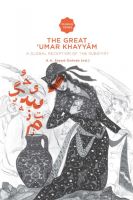Die Rubajat des Omar Chaijam und die deutsche Literatur. Eine glücklose Begegnung. Wohlleben, Joachim. Literaturwissenschaftliches Jahrbuch 12 (1971), pp. 43–96.
Archives
American-Germans and Edward Fitzgerald’s Rubaiyat of Omar Khayyam
American-Germans and Edward Fitzgerald’s Rubaiyat of Omar Khayyam. Sol Gittleman.
American-German Review 29 (1962) nr. 1, p. 23-24.
Edward FitzGerald’s “Rubaiyat of Omar Khayyam” in Germany
Edward FitzGerald’s “Rubaiyat of Omar Khayyam” in Germany. Sol Gittleman.
Notes and Queries (1962), nr. 9, p. 95-96.
List of German translations, but without the versions by Schack, Bodenstedt and Rosen.
The Fame of Omar Khayyam
The Fame of Omar Khayyam. Abd al-Haqq Fádil.
The Muslim World, 50 (1960) 4, pp. 259-268
Omar Khayyam’s popularity has two phases. In his life he was tremendously famous for his copious learning; after his death he became celebrated for his brilliant Rubáiyyát. In both he was unique and matchless. But he did not enjoy his fame completely either in life or in death. It is time now for us to grant him his due in full as a man of learning and as a poet.
A wanderer’s note-book : “Young Parker”
A wanderer’s note-book : “Young Parker”. E.V. Lucas
In: The Sunday Times, January 16, 1938.
E.V. Lucas wonders why none of the employees at Parker’s recognized the qualities of the verses that Fitzgerald sent them to be published in Fraser’s Magazine
The reception of Edward Fitzgerald’s Rubaiyat of Omar Khayyam in England and Germany
The reception of Edward Fitzgerald’s Rubaiyat of Omar Khayyam in England and Germany. Sol Gittleman. University of Michigan, 1961. iii, 259 p.
The Great ‘Umar Khayyám. A Global Reception of the Rubáiyát
The Great ‘Umar Khayyám. A Global Reception of the Rubáiyát. A.A. Seyed-Gohrab. Leiden, Leiden University Press, 2012. 267 p. (Iranian Studies Series). ISBN: 9789087281571.
Omar Khayyam’s Transgressive Ethics and Their Socio-Political Implications in Contemporary Iran
Omar Khayyam’s Transgressive Ethics and Their Socio-Political Implications in Contemporary Iran. A.A. Seyed-Gohrab.
In: Iran Namag, Vol. 5, no. 3 (Fall 2020).
Summary:
In this paper, the author examines several social implications of Khayyam’s poetry and the reception history of the Persian sage (hakim) Omar Khayyam, who has become a personification of transgressive ideas in Persian literary history. The fascination of the author is due not only to Khayyam’s poetic genius (although he is not the author of the majority of quatrains attributed to him), but also to his problematic reception in twentieth-century Iran and how he has been connected to the notion of modernity. Both religious and secular intellectuals have tried to position Khayyam in the modern intellectual history of Iran in their own ways.
Rubaiyat of Omar Khayyam
Rubaiyat of Omar Khayyam
In: Taher-Kermani (Ed.) 2021 – The Persian Presence in Victorian. Edinburgh : Edinburgh University Press, 2021. ISBN: 9781474448161. Pp. 146–173
Summary:
Omar Khayyám is known in Persian literary history as the supreme exponent of the rubáiy (pl. rubáiyát), a short verse from consisting of a single stanza, rhyming aaba. The extent of Khayyám’s fame, however, goes beyond the geographical or cultural boundaries of his place of origin. Thanks to Edward FitzGerald’s translation, Khayyám is now celebrated globally, not just as one of Persia’s classical poets, but as a learned philosopher who, in a collection of epigrammatic poems, has encapsulated some of the largest and most enduring preoccupations of humankind.
